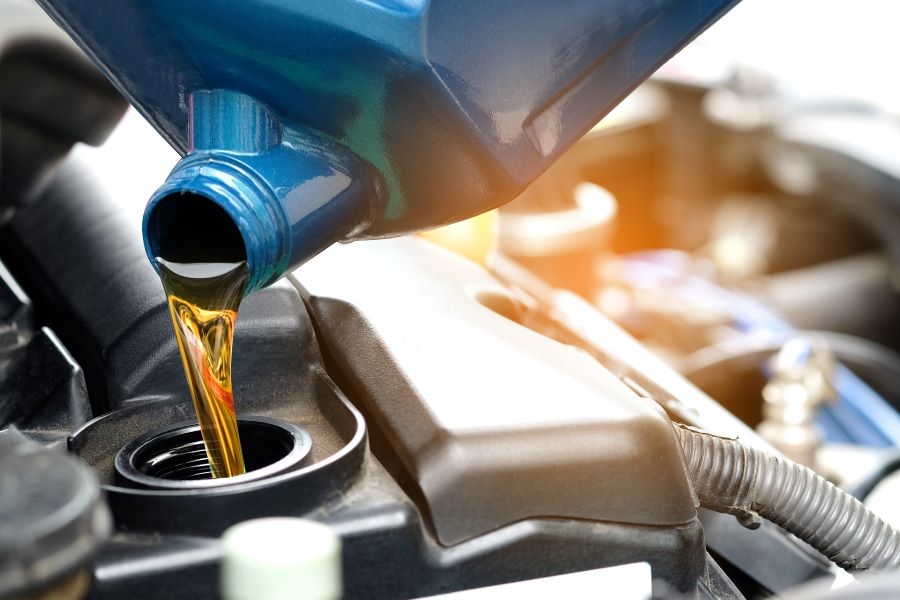Motor oil’s primary job is to lower heat and friction in your engine. With no motor oil to lubricate them, your motor’s moving parts would rub directly against each other, heat up quickly and either melt together or rip each other to shreds within minutes. This guide will give you the information you need to change your oil and keep your engine running smoothly.
Understanding Motor Oil: Types and Grades
The Society of Automotive Engineers (SAE) uses an alphanumeric code to grade different types of oil according to their viscosities — their amount of internal friction — at cold and hot temperatures. This code is generally two numbers separated by a W.
The W represents winter, so the first number tells you about the oil’s flow at cold temperatures. The second number tells you about the oil’s flow at the high temperatures typical in motor operation. The smaller the first number is, the better the oil will run when it’s cold. The higher the second number is, the better the oil will be able to deal with hot temperatures.
Synthetic vs. Conventional Oil: Which One Should You Use?
Motor oil is made from petroleum, synthetic, or blended base oils with a few additives to fight decomposition, oxidization, etc.
Conventional base oils are made by refining crude oil to try to remove contaminants like nitrogen, oxygen, sulfur, and metals and create a smoother petroleum product. The refining process is imperfect, and some of these elements always slip through, reducing the performance of conventional oils.
Synthetic base oils are engineered or modified to contain no contaminants or irregular particles. In general, their uniform structure allows for lower friction, higher fuel efficiency, and better performance at extreme temperatures. They’re more expensive, but they stay useful as a protective barrier for longer, resist sludge formation better, flow more quickly at cold starts, and take longer to break down in hot climates.
DIY Oil Change Basics: A Step-by-Step Guide
If this is your first DIY oil change, it’s important to check your car’s manual or search online to find out the recommended engine oil weight and oil filter model to use. Your owner’s manual can also clarify other DIY oil change basics for your car, including how often to change your oil, how much oil your car needs, and the locations of your oil drain plug, oil filter, and oil cap.
Tools You’ll Need for a DIY Oil Change
Here are the common tools you will need for a DIY oil change:
- Socket or box-end wrench to unscrew the drain plug
- Oil filter wrench
- Container to catch the old oil
- Funnel
- Jack and jack stands or ramps and wheel blocks (optional)
- Gloves (optional)
- Cleanup rags (optional)
- Plastic sheeting (optional)
You’ll also need:
- Correctly sized oil filter
- The right amount of oil for your engine
After you have the necessary tools, you can begin changing your oil according to the following steps.
Step 1
If your car’s engine and oil are a bit warm, the oil will drain out easier. It may help to run the engine for five to 10 minutes and then leave it to cool for a few minutes before starting.
Step 2
Start with your car parked on a level surface with the engine off and the hood open. Make sure the parking brake is engaged.
Step 3
Depending on your car and location’s floor clearance, you may need to use a jack or ramp to raise the car a little in order to reach the oil drain plug. If you use a jack, jack the car up just enough so that you can place the jack stands correctly, and then lower the car onto them. If you use ramps, place wheel blocks behind the rear wheels once you’ve driven the front wheels up onto the ramps.
Step 4
If you have a large, disposable sheet of plastic available, you can spread it on the ground under your oil drain plug and oil filter housing to catch any errant drops that miss your container. Place your oil-catching container on the plastic sheeting under the car’s oil drain plug.
Step 5
Use your socket or box-end wrench to loosen the oil drain plug, and then use your fingers, gloved if you like, to finish unscrewing it. Once you pop out the screw and its accompanying gasket or washer, the oil will start cascading out into your container. Leave it for a few minutes until the flow has stopped, and then screw the drain plug and gasket or washer back in. Use your wrench and some effort to finish tightening the plug, but don’t use all your strength, or you may overtighten it.
Step 6
Move your oil-catching container under the car’s oil filter. Use your oil filter wrench to loosen the oil filter, and then remove it completely with your fingers, letting any remaining oil spill out into your container.
Step 7
Dip a finger into one of your new containers of oil, and rub fresh oil on your new oil filter’s gasket to help it screw on smoothly. Start screwing the new oil filter in by hand, and finish tightening it with your oil filter wrench. Once again, don’t use all your strength.
Step 8
Under the car’s hood, remove the oil cap, and use your funnel to pour in the right amount of new oil.
Step 9
As you wait for the oil to settle, replace the oil cap, check that nothing is leaking underneath your car, and remove your oil-catching container and plastic sheeting. Once the oil settles, check the dipstick to make sure your car has the right amount of oil.
Step 10
Finally, lower your car off the jack stands or ramps, close the hood and start the engine. Let it run for a minute while you make sure the oil pressure is right.
Different Types of Oil Filters: Which One Is Right for You?
Oil filters are classified by the kind of filtering membranes they use:
- Cellulose filters are the most common. They’ll trap most particles measuring around 15-40 microns. You should generally change them about every 3,000 miles.
- Synthetic filters are a bit higher quality. They’ll trap the same particles as cellulose filters plus around half of the particles in the 3-15 micron range. You’ll only have to change them around every 7,000 miles.
- Some of the highest-quality synthetic filters come with an extra microglass layer. This mesh can filter particles as much as 10 times smaller than most cellulose filters. These generally need to be changed only about every two to five years.
Common Oil Change Mistakes to Avoid
You can avoid dropping the oil drain plug into your oil-catching container by pushing the plug slightly inward toward the drain pan while you unscrew it and then quickly reversing directions and pulling it out and away when you feel the last thread come loose.
You can avoid overtightening the oil drain plug and filter by screwing them in mostly by hand and only switching to your wrench for a final quarter turn.
You can avoid making oil disposal mistakes by using your funnel to pour the old oil from your oil-catching container into the empty bottle or bottles your new oil came in. Close the bottles tightly, and search online for where to dispose of motor oil for free and responsibly.
How Often Should You Change Your Oil?
Your car owner’s manual will tell you exactly how often the manufacturer recommends you change your oil. For most cars, this will be around every 5,000-8,000 miles. If you have a newer model and you use synthetic oil, this may stretch to every 10,000 miles. If you have an older model or live in a dusty area, this may shrink to every 3,000 miles.
Tips for Choosing the Right Motor Oil
Here are some helpful tips to assist you in selecting the right oil:
- Thin oils with low viscosity will protect your engine better at cold starts or when the weather is cold.
- Thick oil weights with high viscosity provide better protection when your engine or the weather gets hot.
- New motors generally have finer manufacturing tolerances and run better on thin oils.
- Older motors generally have lower operating tolerances and run better on thick oils.
Frequently Asked Questions
Is 10W30 thicker or 5W30?
These two oils have matching viscosities of 30 at high temperatures. At cold temperatures, 10W30 oil will run thicker than 5W30 oil.
Should I use 5W30 or 10W30?
If temperatures in your area tend to drop below freezing, 5W30 oil will give you better cold starts. If you live in a warmer climate, the slightly more viscous 10W30 is less likely to evaporate at high temperatures.
What oil is thicker, 10W30 or SAE 40?
SAE 40 oil is thicker than 10W30 oil at both low and high temperatures.
Is 10W30 better than 5W40?
Unless your area is subject to extreme temperatures, you probably won’t notice a difference between the two. The 5W40 oil is a bit better for newer, lighter vehicles and cold starts but will probably give you a bit worse fuel economy. The 10W30 oil is a bit better for high-mileage engines and hot weather.
Which oil is better, 10W30 or 10W40?
In colder climates, 10W30 oil runs a bit smoother. In warmer climates, 10W40 oil is a bit more protective against engine wear.
What does 5W40 engine oil mean?
Oil marked 5W40 is multigrade oil that flows well when cold or warm. It will lubricate your engine thoroughly whether the temperature is well below freezing or stiflingly hot.
Visit your nearest True Value store to find everything you need for your DIY oil change.












